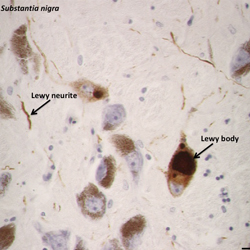Parkinson's Disease

Parkinson’s disease (PD) is the second most common neurodegenerative disorder affecting 1% of the population over the age of 60. Preferential loss of substantia nigra pars compacta (SNc) dopaminergic neurons and their projecting axons to the striatum is a hallmark of PD. These neurons have huge and highly branched axons; the total length of the axon of a single SNc neuron is estimated to exceed 4 metres in humans, forming around 1-2 million synapses. These vulnerable axons are lost early in PD, so preventing this will be essential for any disease modifying therapy.
In the lab, we are using a number of experimental approaches to test whether the activation of the Wallerian pathway contributes to the degeneration of axons both in familial and sporadic PD. These range from in vitro experiments in murine primary neuronal cultures and in vivo studies in mice and zebrafish to analyses on post-mortem human brain tissue. We study both toxin-induced and genetic models of PD. Our goal is to slow down the progression of the disease by targeting the early axonal degeneration occurring in PD.
